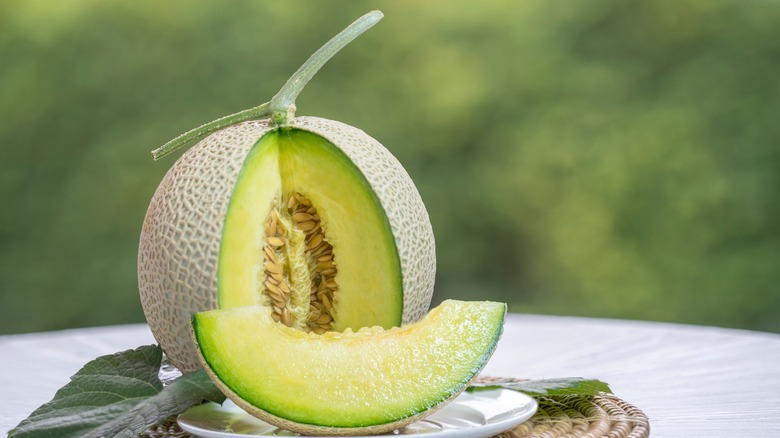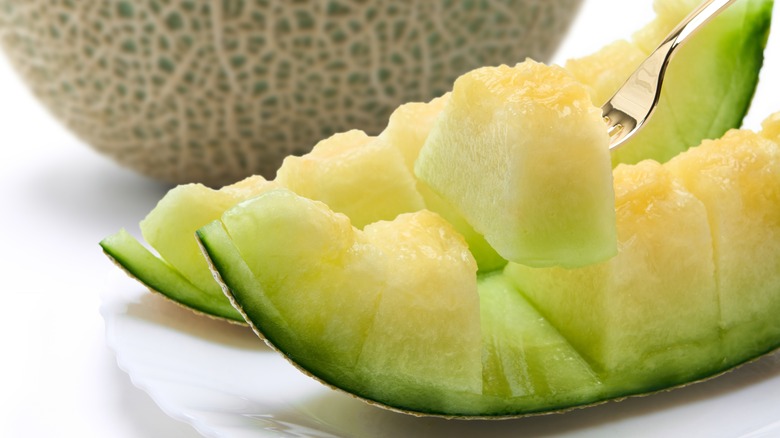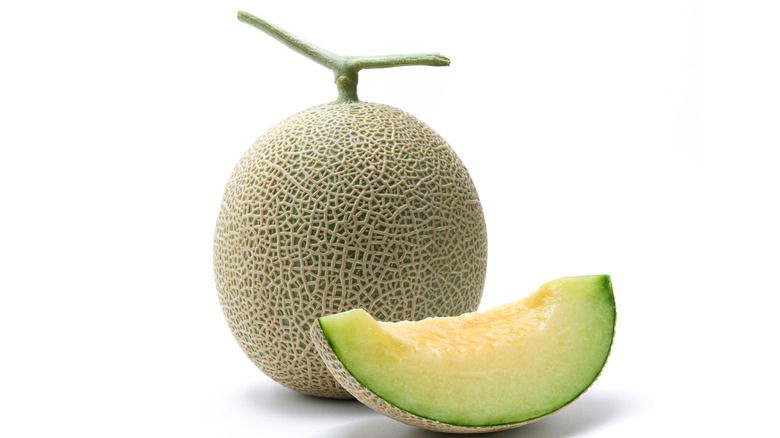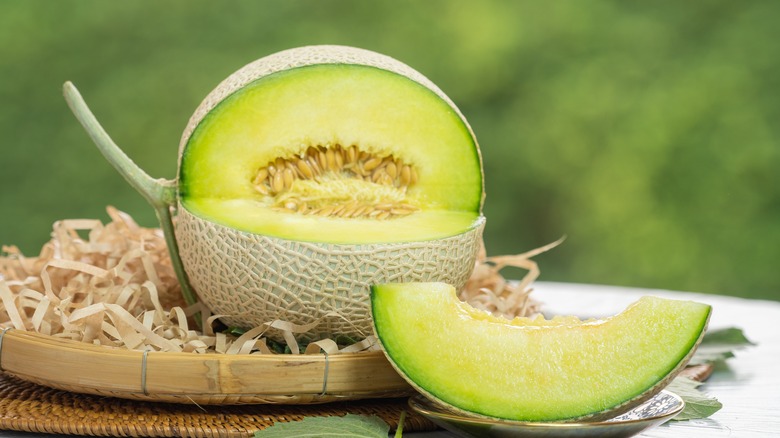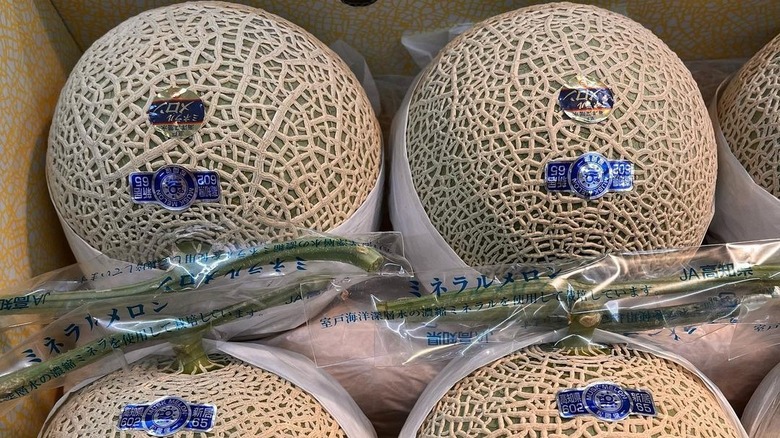Meet The Crown Melon, Japan's $200 Cantaloupe Lookalike
Though it is known as the "Japanese King of Fruits," the crown melon might not strike the unaware as anything special. These melons might look to the untrained eye like any other cantaloupe – albeit topped with a distinctive T-shaped stem. But this melon sells for hundreds, and sometimes thousands, of dollars apiece, and is part of a rich Japanese agricultural tradition of specialty fruits grown to exacting standards.
Crown muskmelons are specially grown in Shizuoka Prefecture on Japan's Pacific coast, and they have been grown in the same manner for about a century. They are grown according to the "one fruit, one tree" method, which is somewhat misleading as the melons (like all melons) are grown on vines, not trees. There is a Japanese symbol similar to the capital letter "T," which stands for this method, and the T-shaped stem of the melon is also emblematic of this tradition. So while this melon may look similar to a cantaloupe with green flesh, it's much more special.
What do crown melons taste like?
Common melons like cantaloupe and honeydew are members of the muskmelon family, which is why their exterior appearance is so similar to that of the crown melon. They also happen to be related to vegetables like squash and zucchini, which explains why these veggies look like skinny melons.
Crown melons have a subtle sweetness typical of the melon family, but because of the incredibly intricate and labor-intensive growing methods used to cultivate them, they are far sweeter than something like a cantaloupe or honeydew melon. When ripe, they give off the strong, musky aroma that gives this fruit family its name. The delicate net that covers the fruit's thick skin gives way when sliced open to a pale green fruit that is so juicy, it almost appears to be melting. The texture, particularly towards the center of the fruit, is so silky and smooth that the flesh seems like it has no fibers at all, as though they have completely disintegrated.
Why are crown melons so expensive?
The crown musk melons are grown in isolation beds raised off of the ground, and each vine is pruned of all but one melon, concentrating all the sugar and nutrients into one, perfect melon. The plants are pollinated by hand using small brushes, which the grower must take to every individual flower. The melons take 100 days to mature, and during that time, both temperature and water are painstakingly controlled in order to produce the sweetest possible fruit, with the most visually appealing exterior. Even slight variations in temperature or hydration can affect the look or taste of the melon.
Another unconventional element of crown musk melon cultivation involves tasking skilled laborers to massage the exterior of the melons to maximize sweetness. As if this weren't enough, on particularly sunny days, crown melons are topped with small caps to keep them from getting sunburnt.
Because of all this effort, crown muskmelons are incredibly expensive. A mid-range price for one melon could be $200, but prices for melons of superior quality can reach tens of thousands of dollars at auction.
Where can you find crown melons?
Crown muskmelons can be ordered online from a variety of Japanese digital marketplaces, usually starting around $120 in price, and going up from there depending on quality. However, most of these retailers do not ship internationally.
If you want to try a crown muskmelon in the U.S. without going to an online market like JAL Shopping, you'll have to seek out one of the few restaurants that serve this specialty. Sake No Hana in New York City is one of the few known for offering this special treat. The Japanese restaurant flies twelve, preordered crown melons in from the Tokyo specialty fruit distributor Shinjuku Takano each month and prepares and serves them tableside along with a sorbet made from melons that have just passed the peak of their ripeness. The melons are so sweet they add no extra sugar to the sorbet. Each melon retails for $250, and customers are presented with a card stamped with the date their melon was cut in order to commemorate the occasion.
How to eat crown melons
Throughout Japan, it is relatively easy to find crown muskmelons in high-end grocery stores and department stores as they are cultivated year-round, and they are part of the important Japanese culture gift giving. You might buy one, for example, to bring to a dinner at your boss's home if you wished to truly show your gratitude.
That said, you still need to make sure you get the best of the best. You can check to see if your crown melon is right by feeling the base of the melon, which should be slightly soft to the touch. Crown melons are prepared similarly to how you might prepare any other kind of melon. The bitter stem is first removed, and then it is halved vertically, has its seeds removed, and is cut into wedges before being eaten.
Once cut, crown musk melons should be consumed within about 24 hours as they are so perfectly ripe and juicy that too much time will cause the melon to deteriorate.

